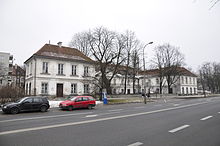Sierakowski Palace
| Sierakowski Palace | ||
|---|---|---|
|
Main facade |
||
| Creation time : | 1754 | |
| Castle type : | Palace | |
| Conservation status: | Reconstructed | |
| Place: | Warsaw | |
| Geographical location | 52 ° 15 '18.5 " N , 21 ° 0' 17.5" E | |
|
|
||

The Sierakowski Palace , also known as Sierakowski Barracks or Konwiktorska Barracks (Polish: Pałac Sierakowskiego , Koszary Sierakowskie or Koszary Konwiktorskie ), is located in the northern part of Warsaw New Town and belongs to the inner city district of the city. The property with the address Ulica Konwiktorska 3/5 has been used as a residence, barracks, hospital and school in the course of its eventful history. There is currently a branch of the National Health Fund NFZ (Polish: Narodowy Fundusz Zdrowia ) here.
history
A first building was erected here between 1754 and 1757 for a Jesuit convict. After it had passed to the castellan of Płock Maksymilian Sierakowski, he had a palace built on the site - presumably including the previous building.
Barracks use
In 1818 the government's war commission (in Polish: Komisja Rządowa Wojny ) acquired the property in order to create apartments for active members and reservists as well as administrative and utility rooms (bakery, laundry, stables and coach houses) for the 4th Infantry Regiment stationed in the nearby Sapieha Palace (the so-called “Czwartaki” or “Children of Warsaw” unit, in Polish : 4 Pułk Piechoty Liniowej - “Czwartaków” or “Dzieci Warszawy”). The renovation and expansion work, which was led by Jakub Kubicki and probably also by Wilhelm Heinrich Minter , was completed in 1820. They gave the palace a late classicist design instead of the earlier late baroque appearance. From 1830 the entire 2nd Battalion of the 4th Infantry Regiment was barracked here.
After the failed November Uprising , the building was used as barracks by troops of the Russian Empire until 1852 and again from 1861 to 1915 . In the meantime, it served as the Hospital of the Holy Spirit (Polish: Szpital Św. Ducha ), which was previously housed in the Palace of Dorota Miączyńska ( Ulica Przyrynek ). From 1861 the Russian Guard Regiment Friedrich Wilhelm III. (Polish: Gwardyjski Sankt-Petersburski Pułk ) from St. Petersburg stationed in the building.
Second republic
After gaining independence in 1919, the barracks buildings initially housed the 1st Motorized Division (Polish: 1 Dywizjon Samochodowy ) and, after the reorganization of the armored troops in 1931, the 2nd Battalion of the 3rd Panzer Regiment (Polish: 3 Pułk Pancerny ) of the Modlin Fortress . After this unit was moved back to Modlin in 1933, a newly created battalion, which later became III. Panzerbataillon ( 3 Batalion Pancerny ) was designated the barracks. Due to the lack of size, the staff, garages and workshops of this unit had to be stationed at Fort Wola . From 1938 these parts were first moved to a barracks in Marymont and then to the nearby Fort Aleksieja .
World War II and post-war period
Parts of the facility burned down during the German attack on Warsaw in 1939. During the particularly bitter fighting during the Warsaw Uprising here, the remains of the buildings that had been spared were also destroyed. From 1951 to 1954 the palace was rebuilt under the direction of Barbara Andrzejewska according to the earlier design by Kubicki. A large western wing of the building was not rebuilt, however, in its place is now school No. 12 ( Ulica Konwiktorska 7 ).
Currently there is an outpatient clinic of the Polish health service in the poorly maintained building. A plaque commemorating the Warsaw Uprising was installed on the west side of the building. Behind the palace is a public fountain adorned with a sculpture of a dancing bear.
References and comments
See also
Web links
- Detailed information with two historical images at Warszawa1939.pl (in Polish)
- Przemysław Miller, Pałac Sierakowskiego on the website of the City of Warsaw from February 2, 2010 (in Polish)
literature
- Julius A. Chroscicki, Andrzej Rottermund: Architectural Atlas of Warsaw. 1st edition. Arkady, Warsaw 1978, p. 77




